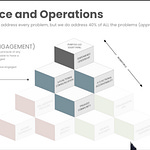You know what the biggest threat to a growing business is? It's not competition. It's not the market. It's not even funding. It's the inefficiencies that don't announce themselves, the silent killers inside your own company.
And they don't hit you all at once. They stack up and slowly. A little more friction and decision-making, a little more wasted time in meetings, a little less clarity on who's doing what. Until one day, everything feels a little bit harder than it should.
That's because misalignment isn't loud. It doesn't scream, hey, something's broken. It hides, it whispers. It's in the gaps between teams, in duplicated work, in decisions that take weeks instead of hours. And over time, these inefficiencies start to chip away at momentum, affecting four critical areas, alignment, people, process, and leadership.
Let's start with alignment. It sounds simple. Every team, every department, every person moving towards the same goal. But here's the problem. Most leaders assume alignment instead of actually confirming it. And that's where the first silent killers start to show up. Things like growth alignment. Does your team actually understand where the organization is going?
Not just the big picture vision, but how their work today affects success next quarter or next year. Collaborative KPIs. Are your teams being measured on shared outcomes or are they fighting against each other? Because if sales is pushing one thing, marketing is focused elsewhere, and products somewhere caught in the middle, you don't have alignment, you have an internal war. And then you have organizational alignment.
As you grow, do roles and decision-making responsibilities evolve with you? Or do people have to guess who's in charge, who makes the call, and who's actually accountable? And when alignment isn't there, you feel it. Decision stall, confusion creeps in, bottlenecks form, and suddenly everything's taking a little bit longer than it should.
People aren't just a resource. They're the engine of your company. But an engine doesn't run without the right fuel. And when that fuel's missing, you see three more silent killers. Engage community. If your team doesn't feel connected to the mission, to their coworkers, to the work itself, they disengage.
And disengagement is worse than turnover because those employees still show up, but they've stopped caring. And cross-functional communication. How often do teams argue over who was supposed to handle something? That's what happens when communication breaks down across departments.
Priorities get misaligned, people work in silos, and the customer pays the price. and cross-functional accountability, does your team feel responsible only to their direct manager? Or do they feel accountable to each other? Because if pure accountability doesn't exist, work falls through the cracks, and it's always someone else's problem. When these things break, you don't always hear complaints, but you'll feel it.
Frustrated employees, teams mis-communicating, and a culture where no one really owns anything. If alignment is the destination and people are the engine, then processes are the road you're actually driving on. And if that role is full of potholes, everything slows down. These three silent killers show up when processes aren't built to support speed, scale, and clarity. We're looking at aligned tech stack.
Do your tools actually work together or are employees wasting hours bouncing between systems that don't talk to each other? Collaborative processes. Are your workflows designed for efficiency and scale, or are they patched together with long email chains, quick check-ins and workarounds that eat up time? And meeting efficacy. Most meetings don't actually need to happen.
Companies lose hundreds of hours every month in meetings that could have been an email. And when meetings aren't run well, people don't just lose time, they lose motivation. And when processes are broken, employees feel it. They stop seeing their job as impactful and start seeing it as just checking boxes. And when that happens, productivity tanks.
Leadership is the driver of everything. If alignment, people, and processes are the vehicle, leadership determines whether you're speeding ahead or swerving into a ditch. And here's where the last two silent killers creep in. Purpose-driven everything. Are leaders making decisions with a clear, defined purpose?
Or are they constantly reacting to problems as they come up, stuck in firefighting mode? Because reactionary leadership keeps a company in crisis. and empowered leadership, does decision-making sit only at the top? Or do people have the authority to act? Because if every decision needs leadership's approval, you're not scaling, you're slowing down.
When leadership isn't aligned with the team, hesitation sets in. People stop making decisions, they wait, they second guess, and that hesitation kills speed.
So let's recap. There are 11 silent killers that quietly drain your company's time, money, and momentum.
And these don't hit all at once, they build slowly. And so one day you wake up and wonder why everything feels harder than it should be.
But here's the good news. You can fix this. And the companies that address these issues early, they don't just scale, they dominate.
So the real question is, how do you spot these silent killers before they take you down?
Visit: LucidORG.com for additional information







